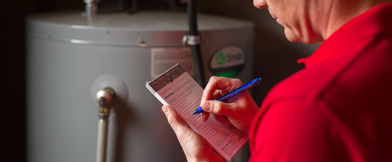No Space for a Water Heater
Richard Trethewey informs a homeowner of the various options for a water heater in a tight space
By Plumbing and heating expert Richard Trethewey of This Old House
 Question:
Question:
I’m told that the old gas boiler that heats my house and my water isn’t made anymore. I don’t have a cellar, and the closet where the boiler is now located doesn’t have room for a water tank. Will I have to put it in my living space?
—Tony Zaffiro, Lynn, MA
Not to worry; there are combination, or “combi,” condensing boilers that should fit nicely in your closet. These compact, tankless units hang on a wall and have a single modulating burner and two heat exchangers—one that warms the water for your radiators and another that captures that water’s heat and transfers it to the separate hot-water supply for bathing and cleaning clothes and dishes.
Combis aren’t cheap—figure about $4,000 installed—and they don’t have the power to heat a large house. But they’re about 95 percent efficient, an incredible improvement over the boilers and water heaters available even 10 years ago. You’ll probably see a payback in five to seven years, compared with what you now pay for heat and hot water. And because the modulating burner precisely regulates its heat output, you won’t have the uncomfortable indoor temperature swings common with less sophisticated systems.
The first step is to work with a hydronic heating pro to establish—through a Manual J heat-loss calculation—how much heat, in Btus, escapes from your house on the coldest winter night. You’ll want a combi unit that has a Btu output to match, no bigger.
Your pro also needs to make sure your existing gas supply is sufficient, and has to find a way to vent the exhaust gases. Sidewall venting is usually the easiest option, as long as there are no windows or doors within a foot of the exhaust. These gases are so cool, a PVC pipe can handle them. The units also require a neutralizer to treat the acidic condensate and a pump to carry it away to a drain.
Finally, check your water’s hardness. Tankless units build up scale rapidly when water is full of minerals. You may need a softening or conditioning system to keep the buildup at bay and your system functioning reliably.
